Chapter 7 Aggregate Demand and Aggregate Supply Model
1/53
Earn XP
Name | Mastery | Learn | Test | Matching | Spaced |
|---|
No study sessions yet.
54 Terms
Aggregate demand:
a. is comprised of spending on domestic output by consumers, businesses, foreigners, and government.
b. reflects the inverse relationship between the price level and the quantity of real GDP demanded.
c. graphs as a curve that slopes downward to the right due to the real balance effect and the international trade effect.
d. All of the above statements regarding aggregate demand are true.
d. All of the above statements regarding aggregate demand are true.
The downward-sloping aggregate demand curve indicates that, ceteris paribus:
a. there is an inverse relationship between demand and the average level of prices.
b. a greater quantity of real GDP will be demanded at higher price levels than at lower price levels.
c. a decrease in the price level leads to an increase in the quantity demanded of real GDP.
d. inflation and output are directly related.
c. a decrease in the price level leads to an increase in the quantity demanded of real GDP
Assuming nothing else changes, for a given money income, an increase in the domestic price level leads to:
a. an increase in real income and an increase in purchasing power.
b. a decrease in real income and a decrease in purchasing power.
c. an increase in real income and a decrease in purchasing power.
d. a decrease in real income and an increase in purchasing power.
b. a decrease in real income and a decrease in purchasing power.
According to the real balance effect, the real value of a given amount of money:
a. is not affected by changes in the price level.
b. increases as the price level increase.
c. increases as the price level decreases.
d. inflation and prices are inversely related.
c. increases as the price level decreases.
According to the international trade effect:
a. when the domestic price level falls, exports become cheaper and imports become more expensive, ceteris paribus.
b.an increase in the domestic price level leads to a decrease in net exports, ceteris paribus.
c. the aggregate demand curve slopes downward to the right, ceteris paribus.
d. All of the above are true according to the international trade effect.
d. All of the above are true according to the international trade effect.
Ceteris paribus, aggregate demand will decrease (shift to the left) when there is:
a. an increase in personal wealth.
b. an increase in foreign real national income.
c. an increase in consumer optimism.
d. an increase in interest rates.
d. an increase in interest rates.
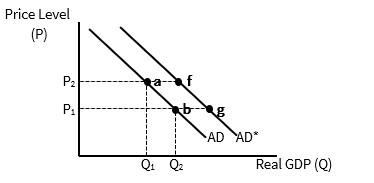
A decrease in the price level:
a. is illustrated by a movement along the AD curve from point a to b, and leads to an increase in aggregate demand.
b. is illustrated by a movement along the AD curve from point a to b, and leads to an increase in the quantity demanded of real GDP.
c. results in a shift of the AD curve to the right, such as going from point b on AD to point g on AD*.
d. results in a shift of the AD curve to the left, such as going from point f on AD* to point a on AD.
b. is illustrated by a movement along the AD curve from point a to b, and leads to an increase in the quantity demanded of real GDP.
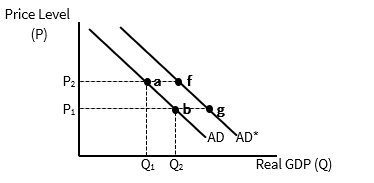
Businesses becoming more pessimistic about future sales and profits:
a. is illustrated by a movement along the AD curve from point a to b, and leads to an increase in aggregate demand.
b. is illustrated by a movement along the AD curve from point a to b, and leads to an increase in the quantity demanded of real GDP.
c. results in a shift of the AD curve to the right, such as going from point b on AD to point g on AD*.
d. results in a shift of the AD curve to the left, such as going from point f on AD* to point a on AD.
d. results in a shift of the AD curve to the left, such as going from point f on AD* to point a on AD.
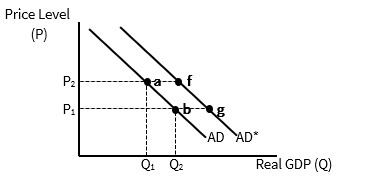
Ceteris paribus, an increase in aggregate demand:
a. could be caused by a decrease in personal taxes and is illustrated by a rightward shift from AD to AD*.
b. could be caused by a decrease in personal taxes and is illustrated by moving from point a to point b on AD.
c. could be caused by a decrease in the price level and is illustrated by moving from point a to point b on AD.
d. could be caused by a decrease in the price level and is illustrated by going from point a on AD to point f on AD*.
a. could be caused by a decrease in personal taxes and is illustrated by a rightward shift from AD to AD*.
An increase in government spending on infrastructure leads to:
a. an increase in AD and a movement down along the AD curve.
b. an increase in AD and a rightward shift of the AD curve.
c. a decrease in AD and a movement up along the AD curve.
d. a decrease in AD and a leftward shift of the AD curve.
b. an increase in AD and a rightward shift of the AD curve.
If the quantity supplied of real GDP increases as the price level increases, then:
a. the short-run aggregate supply curve is horizontal.
b. the short-run aggregate supply curve is vertical.
c. the short-run aggregate supply curve is upward sloping.
d. the short-run aggregate supply curve is downward sloping.
c. the short-run aggregate supply curve is upward sloping.
The direct (positive) relationship between the quantity of real GDP suppliers are willing and able to make available at alternative price levels is illustrated by:
a. a downward-sloping aggregate demand curve.
b. an upward-sloping short-run aggregate supply curve.
c. a downward-sloping long-run aggregate supply curve.
d. any combination of outputs on the production possibilities frontier.
b. an upward-sloping short-run aggregate supply curve.
Ceteris paribus, an increase in the price level leads to:
a. an increase in the quantity supplied of real GDP and a movement along the SRAS curve.
b. an increase in the quantity supplied of real GDP and a rightward shift of the SRAS curve.
c. a decrease in the quantity supplied of real GDP and a movement along the SRAS curve.
d. a decrease in the quantity supplied of real GDP and a leftward shift of the SRAS curve.
a. an increase in the quantity supplied of real GDP and a movement along the SRAS curve.
The SRAS curve slopes upward to the right because:
a. in the short run, some inputs and costs of production are fixed, which means suppliers are not able to increase output prices.
b. in the short run, some inputs and costs of production are fixed, which means suppliers earn more profit if prices are rising.
c. government requires suppliers who increase prices to also increase output.
d. government sets the price level to encourage suppliers to produce more output and employ more workers.
b. in the short run, some inputs and costs of production are fixed, which means suppliers earn more profit if prices are rising.
Which of the following events will lead to a leftward shift of the short-run aggregate supply curve?
a. A decrease in the price level
b. A decrease in government expenditures
c. An adverse supply shock
d. An increase in productivity
c. An adverse supply shock
Decreases in wages and other input prices lead to:
a. decreases in costs of production which increases SRAS.
b. decreases in costs of production which decreases SRAS.
c. increases in costs of production which increases SRAS.
d. increases in costs of production which decreases SRAS.
a. decreases in costs of production which increases SRAS.
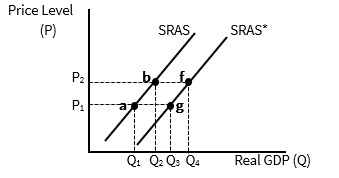
An increase in the price level, ceteris paribus, is illustrated by:
a. a rightward shift from SRAS to SRAS*.
b. a leftward shift from SRAS* to SRAS.
c. a movement from point b on SRAS to point f on SRAS*.
d. a movement from point a to point b along SRAS.
d. a movement from point a to point b along SRAS.
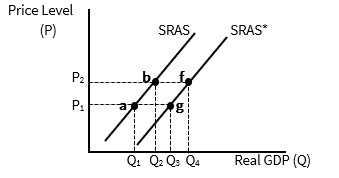
An increase in costs of production is illustrated by:
a. a rightward shift from SRAS to SRAS*.
b. a leftward shift from SRAS* to SRAS.
c. a movement from point b on SRAS to point f on SRAS*.
d. a movement from point a to point b along SRAS.
b. a leftward shift from SRAS* to SRAS.
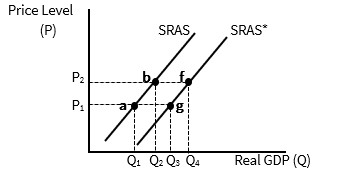
Which of the following will cause SRAS to shift right to SRAS*?
a. An increase in the price level
b. A decrease in the price level
c. A beneficial (positive) supply shock
d. An adverse (negative) supply shock
c. A beneficial (positive) supply shock
All of the following statements are true EXCEPT:
a. an increase in the price level leads to an increase in the quantity supplied of real GDP, ceteris paribus.
b. a decrease in the price level leads to a decrease in the quantity supplied of real GDP, ceteris paribus.
c. an increase in costs of production leads to an increase in SRAS, ceteris paribus.
d. a decrease in costs of production leads to an increase in SRAS, ceteris paribus.
c. an increase in costs of production leads to an increase in SRAS, ceteris paribus.
Macroeconomic equilibrium occurs:
a. at the price level for which aggregate demand is equal to aggregate supply.
b. at the price level for which the quantity demanded of real GDP is equal to the quantity supplied of real GDP.
c. only when actual real GDP is equal to potential real GDP.
d. only when the macroeconomic goals of full employment, price stability, and economic growth have been met.
b. at the price level for which the quantity demanded of real GDP is equal to the quantity supplied of real GDP.
Ceteris paribus, when the short-run aggregate supply curve is upward sloping, an increase in aggregate demand leads to a new equilibrium at a:
a. higher level of output and a lower price level.
b. higher level of output and a higher price level.
c. lower level of output and a lower price level.
d. lower level of output and a higher price level.
b. higher level of output and a higher price level.
Ceteris paribus, when the short-run aggregate supply curve is upward sloping, an increase in short-run aggregate supply leads to a new equilibrium at a:
a. higher level of output and a lower price level.
b. higher level of output and a higher price level.
c. lower level of output and a lower price level.
d. lower level of output and a higher price level.
a. higher level of output and a lower price level.
Ceteris paribus, when the short-run aggregate supply curve is upward sloping, an increase in interest rates:
a. increases aggregate demand which leads to a new equilibrium at a higher level of output, a lower unemployment rate, and a higher price level.
b. increases short-run aggregate supply which leads to a new equilibrium at a higher level of output, a lower unemployment rate, and a lower price level.
c. decreases aggregate demand which leads to a new equilibrium at a lower level of output, a higher unemployment rate, and a lower price level.
d. decreases short-run aggregate supply which leads to a new equilibrium at a higher level of output, a lower unemployment rate, and a lower price level.
c. decreases aggregate demand which leads to a new equilibrium at a lower level of output, a higher unemployment rate, and a lower price level.
Ceteris paribus, when the short-run aggregate supply curve is upward sloping, a beneficial (positive) supply shock:
a. increases aggregate demand which leads to a new equilibrium at a higher level of output, a lower unemployment rate, and a higher price level.
b. increases short-run aggregate supply which leads to a new equilibrium at a higher level of output, a lower unemployment rate, and a lower price level.
c. decreases aggregate demand which leads to a new equilibrium at a lower level of output, a higher unemployment rate, and a lower price level.
d. decreases short-run aggregate supply which leads to a new equilibrium at a higher level of output, a lower unemployment rate, and a lower price level.
b. increases short-run aggregate supply which leads to a new equilibrium at a higher level of output, a lower unemployment rate, and a lower price level.
The long-run aggregate supply curve (LRAS) curve is:
a. vertical at the economy's natural (full employment) level of real GDP.
b. vertical at the short-run equilibrium level of real GDP.
c. upward-sloping because firms respond to higher prices by producing more output.
d. upward-sloping because resources and technology are assumed to be fixed.
a. vertical at the economy's natural (full employment) level of real GDP.
The vertical long-run aggregate supply implies that:
a. changes in aggregate demand will have no effect on the price level in the long run.
b. the short-run aggregate supply curve is also vertical.
c. natural (full-employment ) real GDP does not depend on the price level in the long run.
d. natural (full-employment ) real GDP is the same as equilibrium real GDP in the short run.
c. natural (full-employment ) real GDP does not depend on the price level in the long run.
An increase in the amount of resources available for production and improved production technology lead to:
a. increases in aggregate demand, which are inflationary.
b. increases in SRAS, which are inflationary.
c. economic growth, which is best illustrated by a rightward shift of the SRAS curve.
d. economic growth, which is best illustrated by a rightward shift of the LRAS curve.
d. economic growth, which is best illustrated by a rightward shift of the LRAS curve.
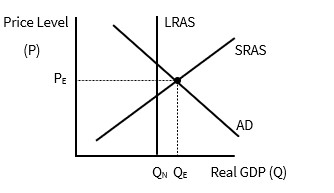
The economy depicted in the graph is experiencing:
a. equilibrium at full employment because actual GDP is equal to potential GDP.
b. an inflationary long-run equilibrium because actual GDP is lower than potential GDP.
c. an inflationary gap because actual GDP is higher than potential GDP.
d. a recessionary gap because actual GDP is lower than potential GDP.
c. an inflationary gap because actual GDP is higher than potential GDP.
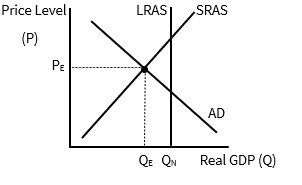
The economy depicted in the graph is experiencing:
a. equilibrium at full employment because actual GDP is equal to potential GDP.
b. an inflationary long-run equilibrium because actual GDP is higher than potential GDP, and the GDP gap is negative.
c. an inflationary gap because actual GDP is higher than potential GDP.
d. a recessionary gap because actual GDP is lower than potential GDP.
d. a recessionary gap because actual GDP is lower than potential GDP.

The economy depicted in the graph is:
a. in a recessionary gap.
b. in an inflationary gap.
c. at a full-employment equilibrium.
d. on its long-run aggregate supply curve.
a. in a recessionary gap.
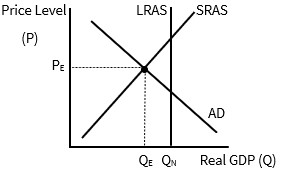
The graph suggests that a main macroeconomic problem facing this economy is:
a. unemployment.
b. inflation.
c. accelerated economic growth.
d. overemployment.
a. unemployment.

The economy depicted in the graph is:
a. in a recessionary gap.
b. in an inflationary gap.
c. at a full-employment equilibrium.
d. on its long-run aggregate supply curve.
b. in an inflationary gap.
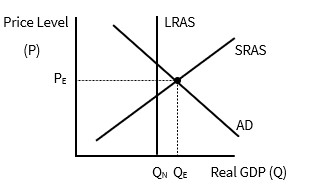
The graph suggests that a main macroeconomic problem facing this economy is:
a. unemployment.
b. inflation.
c. stagnant economic growth.
d. underemployment.
b. inflation.
If the economy is initially in equilibrium at natural real GDP (full-employment real GDP), a decrease in investment spending will:
a. increase aggregate demand, resulting in an increase output, an increase in the price level, and a decrease in the unemployment rate.
b. increase short-run aggregate supply, resulting in an increase in output, a decrease in the price level, and a decrease in the unemployment rate.
c. decrease short-run aggregate supply, resulting in a decrease in output, an increase in the price level, and a decrease in the unemployment rate.
d. decrease aggregate demand, resulting in a decrease in output, a decrease in the price level, and an increase in the unemployment rate.
d. decrease aggregate demand, resulting in a decrease in output, a decrease in the price level, and an increase in the unemployment rate.
If the unemployment rate is greater than the natural rate of unemployment, a(n):
a. recessionary gap exists and equilibrium real GDP is less than natural real GDP.
b. recessionary gap exists and equilibrium real GDP is greater than natural real GDP.
c. inflationary gap exists and equilibrium real GDP is less than natural real GDP.
d. inflationary gap exists and equilibrium real GDP is greater than natural real GDP.
a. recessionary gap exists and equilibrium real GDP is less than natural real GDP.
If the unemployment rate is less than the natural rate of unemployment, a(n):
a. recessionary gap exists and equilibrium real GDP is less than natural real GDP.
b. recessionary gap exists and equilibrium real GDP is greater than natural real GDP.
c. inflationary gap exists and equilibrium real GDP is less than natural real GDP.
d. inflationary gap exists and equilibrium real GDP is greater than natural real GDP.
d. inflationary gap exists and equilibrium real GDP is greater than natural real GDP.
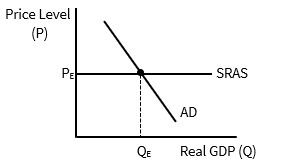
Suppose the short-run aggregate supply curve (SRAS) is horizontal at a fixed price level, as illustrated in the graph. This suggests that:
a. an increase in aggregate demand will lead to an increase in output with no increase in the price level, ceteris paribus.
b. an increase in aggregate demand will lead to an increase in output with no decrease in the unemployment rate, ceteris paribus.
c. changes in aggregate demand will have no impact on output, prices, or employment.
d. the economy is in long-run equilibrium.
a. an increase in aggregate demand will lead to an increase in output with no increase in the price level, ceteris paribus.
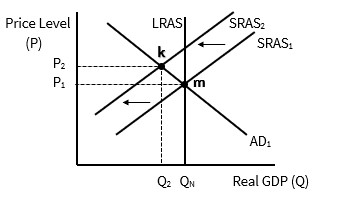
Suppose an economy is initially in equilibrium at point m. The economy is likely to move to equilibrium at point k as a result of:
a. a decrease in consumer confidence.
b. an increase in personal income taxes.
c. a decrease in the wage rate.
d. an adverse (negative) supply shock.
d. an adverse (negative) supply shock.
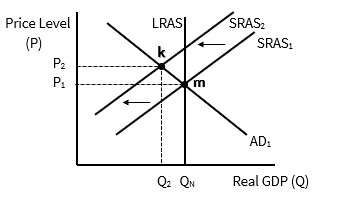
If the economy settles at an equilibrium at point k, then the result is likely to be a period of:
a. deflation.
b. stagflation.
c. expansion.
d. None of the above is suggested by equilibrium at point k.
b. stagflation.
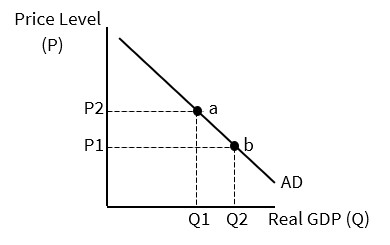
In the graph below, increasing the price level from P1 to P2:
a. increases the quantity demanded of real GDP which is shown as a movement point a to point b.
b. decreases the quantity demanded of real GDP which is shown as a movement from point b to point a
c. increases the demand for real GDP which is shown as a movement from point a to point b.
d. decreases the demand for real GDP which is shown as a movement from point b to point a.
b. decreases the quantity demanded of real GDP which is shown as a movement from point b to point a
Which of the following events will NOT increase aggregate demand in U.S. and cause the AD curve to shift to the right?
a. An increase in income and wealth for American consumers
b. An increase in American business optimism regarding future sales and profits
c. An increase in interest rates in the U.S.
d. Depreciation of the U.S. dollar relative to foreign currencies
c. An increase in interest rates in the U.S.
Increase in consumer income and wealth
Increase in AD
Pessimistic business expectations
Decrease in AD
Unexpected sharp increase in the price oil
Decrease in SRAS
Decrease in costs of production
Increase in SRAS
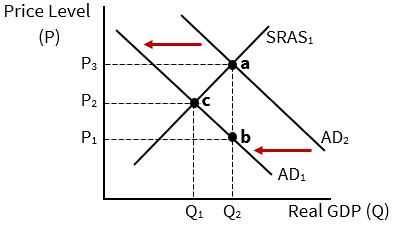
Suppose the economy is initially in equilibrium at point a. A decline in consumer confidence causes AD to ________ and shift left, as illustrated in the graph. The new equilibrium will be at point _______. The price level is ________ than at point a, and the equilibrium level of output is _______ than at point a.
decrease, c, lower, lower
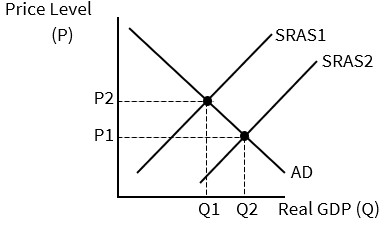
The shift from SRAS1 to SRAS2 in the graph below:
a. could be a result of a beneficial, or positive, supply shock.
b. could be a result of lower wages.
c. illustrates an increase in short-run aggregate supply.
d. All of the above are true regarding the shift from SRAS1 to SRAS2.
d. All of the above are true regarding the shift from SRAS1 to SRAS2.
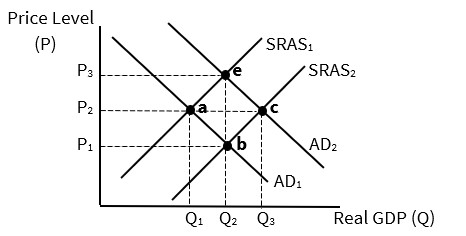
Stock market and employment boom
From point a to point e
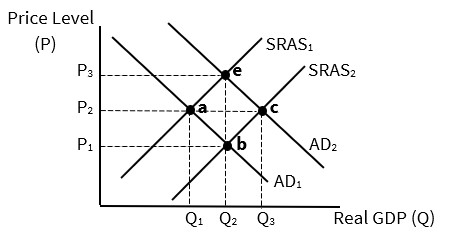
Adverse (negative) demand shock
From point c to point b
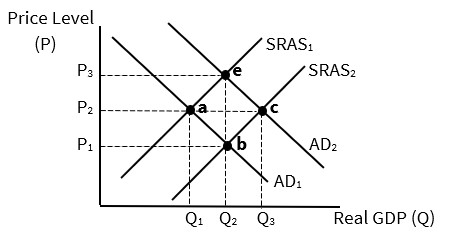
Increase in costs of production
From point b to point a
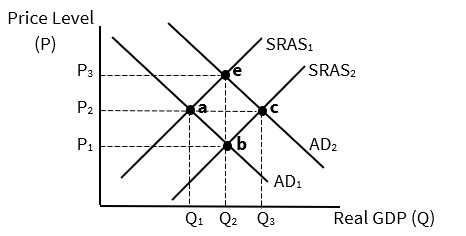
Beneficial (positive) supply shock
From point e to point c
When actual real GDP is less than potential (natural) real GDP, there is a(n) _________ gap. When actual real GDP is greater than potential (natural) real GDP, there is a(n) _______ gap.
recessionary, inflationary
Ceteris paribus, all of the following are true with respect to macroeconomic equilibrium EXCEPT:
a. an economy experiences stagflation when high levels of unemployment are accompanied by high levels of inflation for a prolonged period.
b. when a full-employment economy experiences a negative (adverse) supply shock, the result is a lower price level, a lower level of output, and a higher level of unemployment.
c. a recessionary gap may emerge if a full-employment economy experiences a decrease in aggregate demand.
d. there is a trade-off between unemployment and inflation when aggregate demand changes.
b. when a full-employment economy experiences a negative (adverse) supply shock, the result is a lower price level, a lower level of output, and a higher level of unemployment.